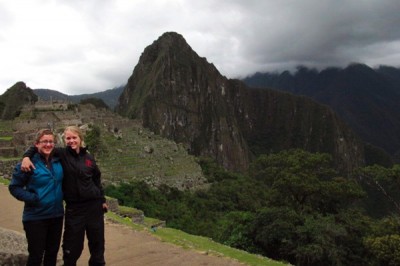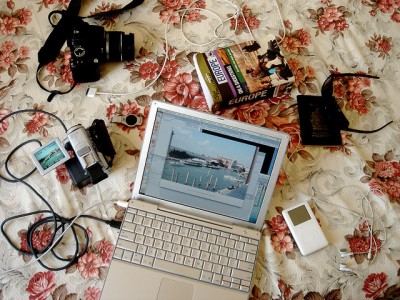
When it comes to packing for an international trip, I’ve always tried to live by the maxim, “if you’d be heartbroken to lose it, don’t bring it.”
That means I’ll never take along my favorite old comfy T-shirt no matter how much I’d like to have it with me, for fear that it would be left behind in some hotel room or stolen inadvertently out of my backpack.
It’s a little harder to apply this packing maxim to technology. Sure, the more techy gear you take with you, the more time you spend worrying about keeping it safe. But our lives have become so technology saturated that it can be hard to let go.
When deciding what gadgets you’ll bring on a trip, ask yourself what kind of a travel experience you want to have. Do you need to completely “unplug” in order to feel like you’ve had a vacation, or is it more important to you to be able to keep in touch with friends and family back home? Do you worry that having a camera lens between you and your experiences will make them less “authentic,” or are pictures important to maintaining and sharing your trip’s memories?
It’s all about finding the right balance of technology for you.
Internet-ing
My folks traveled for 10 years before I was born. They told me their parents probably heard from them about once a month during that time, through a postcard or occasional telegram (yes, I said telegram). That is an experience I’ve never had. My first international trip on my own was to Egypt and Greece in 1998, and there were already plenty of Internet cafés around. If my parents didn’t hear from me every few days, they kind of freaked out.
I love to write blog entries and keep people updated at home, and it’s really nice to be in touch via email, especially on days when I’m feeling homesick. But there are times when I feel resentful about having to spend an hour or two in an internet café when I’d rather be out exploring a new place. Sometimes I need a break from being connected, to just experience all the new things around me.
This used to be easier, like when I spent a week in 2003 in a Guatemalan town with only one phone and no computer to be seen (I hear from friends who’ve gone back there that now several internet cafés line the main street). But even in Southeast Asia in 2006, it was possible to find secluded spots where the Internets had not yet reached, and truly unplug (as long as I told my parents I’d be out of range for a few days first).
Laptops vs. Mobile wifi
I have friends who have gone traveling with a laptop, and I know some of them have found it to be very useful. But carrying something that large and expensive has always seemed too cumbersome. Still, as wifi has become more prevalent all over the world, I have begun to see how packing your own wifi access could come in handy.

So on my last trip, to Peru this winter, I packed my 3-year-old iphone (I probably wouldn’t have brought it if it had been newer), I kept it in airport mode the entire time to avoid the insane fees, and just used it when there was wifi. In the Houston airport on the way to Lima, I wandered into an electronics store and decided to add a rubber roll-out Bluetooth keyboard to my setup for good measure. I just couldn’t see myself pecking out a compelling blog entry on that tiny keyboard.
I used that setup to write blogs and email when we could find a hotel that had a decent connection, and didn’t have to worry about carrying (and losing) an expensive laptop.
One word of warning: most hotels claim to have reliable wifi these days, but not all of them actually do! I’ve spent a lot of time huddling in hallways or on rooftops trying to get a stronger signal.
Skype
I also bought myself some Skype credit before I left and used the phone in wifi mode to call home; $10.00 got me hours of talking time. It was surreal and wonderful to be chatting casually to my girlfriend while sitting on the balcony of my Lima hostel just a couple hours after I landed.
But there were times when I worried that I was actually too connected to home and needed to pull myself back into the moment and place I was in. Still, I was incredibly grateful for my Skype and wifi setup, especially when it helped me through a very difficult couple of days after a friend back home passed away unexpectedly in the middle of my trip.
Music
I’m a DJ so music is pretty much the most important thing for me to carry around. Even at home in Seattle, I usually have my iPod, headphones and often a small speaker with me wherever I go. Bringing music (and videos and photos) from home on an iPod or similar device does more than just entertain though; it’s also about being able to carry the things you love around with you and share them as you go.

My travel companion Betsey and I used to be radio DJs together in college, and sharing music with each other via speakers or with a “Y” (an adapter that allows two people to plug headphones into the same device) is one of our favorite things about traveling together. So when the Y that I brought along broke a week into the trip, we searched high and low for a new one. This led to many amusing conversations in Spanish as I tried to explain exactly what I was looking for.
Finding the new Y was a fun adventure in itself, and one in which we were eventually successful, thanks to the fantastic electronics market we stumbled upon in the city of Chiclayo.
Cameras
Bringing a video and/or still camera along on a trip allows you to capture your experiences and share your travels with others. But it also absolutely changes the way you look at things. Are you searching for a perfect shot, or enjoying the moment? Can you control your shutterbug instincts enough to do both?
If having technology changes the way you look at things, it changes how others see you as well. Having a camera around your neck, especially in a third world country, is a mark of wealth and leisure. It points to you as a tourist, whether that is what you consider yourself to be or not, and it will inevitably change how local folks interact with you. I learned this firsthand while spending a few months in Ghana in 1999. The best thing about my camera being stolen on that trip was not having the (metaphorical) weight of carrying it around any longer.
I only recently started traveling with a camera myself. In Peru, and on my last trip to Mexico before that, I loved capturing the small details so much that I would often go for long walks by myself just to photograph as much as I could. But there were other days when I didn’t feel like taking my camera with me at all, because it just seemed to get in the way of whatever else I wanted to do that day.
For me, it’s important that I be in control of choosing when I want to use my camera, instead of feeling I simply have to capture everything (which is impossible anyway).
Tech frivolity

I work hard to pack light when I travel internationally but with all the items I’ve mentioned so far and the accessories to go with them, tech gear took up a lot of space in my bags on my most recent trip.
If you’re a geek like me, it’s easy to go overboard with all the techy travel goodies out there. But you don’t want technology to take over your trip. Here are a few items that didn’t make my cut: pocket-sized translators, hair dryers and electric shavers, travel alarm clocks, gaming and GPS devices, even a travel door alarm.
Safety
I never go on a long international trip without purchasing travel insurance. You can get a lot of coverage for a small amount, and while it still doesn’t feel great to have your mp3 player stolen, it feels a lot better knowing you’ll be reimbursed. Make sure you document your tech items before you go, taking photos and recording serial numbers if possible. Take a copy of your travel insurance info with you, and get local police reports if anything does get stolen.
When it comes to keeping your technology safe while you’re moving around a lot, you basically have two options: carry it with you everywhere, or leave it somewhere you trust. When you are carrying technology with you, keep your bags tightly zipped and an eye (and a hand) on them.
Even with this diligence, on a long enough timeline it’s inevitable that one of your gadgets will get lost or stolen. But the most important thing is that you stay safe and have a good time.
After all, it’s just stuff.

